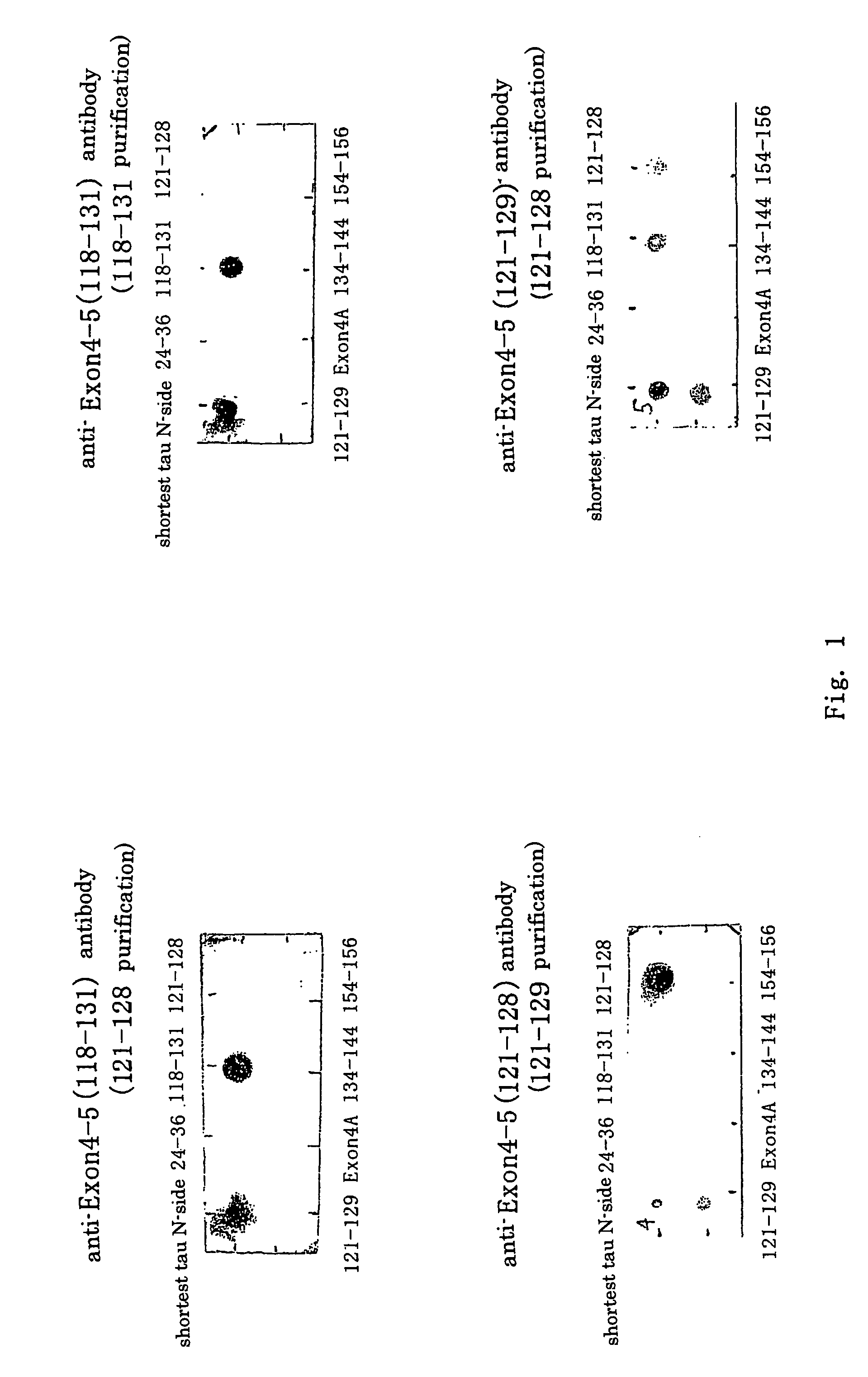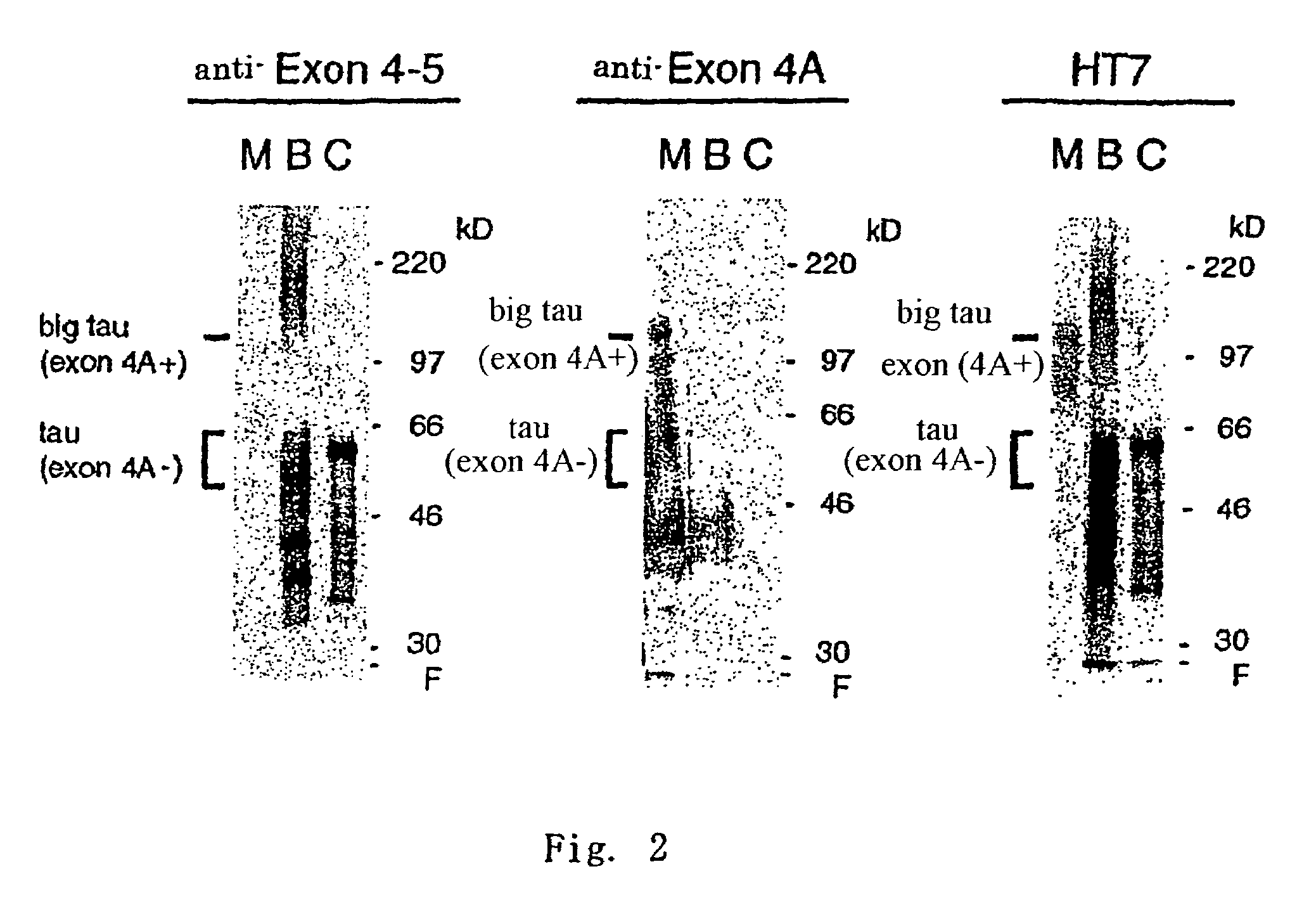Antibody specific to central nervous system tau protein
a central nervous system and tau protein technology, applied in the field of antibodies, can solve the problems of interference in detection of cns tau protein, inability to specifically analyze a change in cns tau protein, and difficulty in collecting samples, etc., and achieves the effect of high specificity, convenient use and sensitiveness
- Summary
- Abstract
- Description
- Claims
- Application Information
AI Technical Summary
Benefits of technology
Problems solved by technology
Method used
Image
Examples
example 1
Preparation and Evaluation of an Antibody
[0087]An antibody specific to a CNS tau protein was prepared according to the description of International Publication No. WO97 / 34145 as follows. Three polypeptides 118-131 (SEQ ID NO: 3), 121-128 (SEQ ID NO: 4), and 121-129 (SEQ ID NO: 5) were used as antigenic polypeptides. The resulting anti-sera were respectively purified using an affinity column on which a particular purified polypeptide for each of the anti-sera were immobilized, and the specificity of each of the antibodies were confirmed by dot blot analysis.
(1) Anti-Exon 4-5 (118-131) Antibody
[0088]A polypeptide 118-131 (SEQ ID NO: 3) to which cysteine was added at the amino end thereof was chemically synthesized as an antigenic polypeptide and bound to keyhole limpet hemocyanin (KLH), followed by the repeated immunization of a rabbit with the polypeptide to obtain antiserum. Specifically, 35 mg of KLH (a freeze-dried product; manufactured by Pierce) was dissolved in 7 mL of pure wat...
example 2
Detection of CNS Tau Protein in Human Cerebrospinal Fluid by ELISA
[0098]Using the anti-Exon 4-5 (118-131) antibody (121-128 purification) selected in the above Example 1, analysis with cerebrospinal fluid as a sample was carried out by enzyme-linked immunosorbent assay (ELISA). In addition, using a tau-protein measuring kit (Finoscolor hTAU or INNOTEST hTAU Ag) commercially available from Innogenetics, measurement was carried out and compared with the method with the antibody of the present invention.
(1) Preparation of Human Cerebrospinal Fluid (CSF)
[0099]Cerebrospinal fluid as a sample was collected from each of an individual suspected of Alzheimer's disease (AD) and an individual having a neurological disease other than dementia (Control; CTL) by lumbar puncture under anesthesia after informed consent. The fluid was then centrifuged to obtain a supernatant for use.
(2) Immobilization of Anti-Human Tau Protein Antibody
[0100]To a 96-well ELISA plate, a 0.1 M sodium carbonate buffer (...
example 3
Detection of CNS Tau Protein in Human Brain and Muscle Tissue by ELISA
(1) Preparation of Sample
[0108]For the sample of a brain tissue, a tau protein was extracted and purified from a brain tissue obtained at the time of the autopsy of an Alzheimer's disease patient (provided by Dr. Hiroyuki Shimada at the Tokyo Metropolitan Geriatric Medical Center in 1990) according to a method described in International Publication No. WO97 / 341345 (a method in accordance with a method described in H. Ksiezak-Reding et al., Journal of Neuroscience Research, 25, 412-419, 420-430 (1990)). A commercially available human muscle tissue extract (Cat No. #7804-1, from CLONTECH Laboratories, Inc.) was used as the sample of a muscle tissue.
[0109]Those samples were used to carry out measurement by enzyme-linked immunosorbent assay (ELISA) in the same manner as in the above Example 2.
(2) Immobilization of Anti-Human Tau Protein Antibody
[0110]An anti-human tau protein monoclonal antibody HT7 was immobilized on...
PUM
| Property | Measurement | Unit |
|---|---|---|
| pH | aaaaa | aaaaa |
| pH | aaaaa | aaaaa |
| pH | aaaaa | aaaaa |
Abstract
Description
Claims
Application Information
 Login to View More
Login to View More - R&D
- Intellectual Property
- Life Sciences
- Materials
- Tech Scout
- Unparalleled Data Quality
- Higher Quality Content
- 60% Fewer Hallucinations
Browse by: Latest US Patents, China's latest patents, Technical Efficacy Thesaurus, Application Domain, Technology Topic, Popular Technical Reports.
© 2025 PatSnap. All rights reserved.Legal|Privacy policy|Modern Slavery Act Transparency Statement|Sitemap|About US| Contact US: help@patsnap.com


